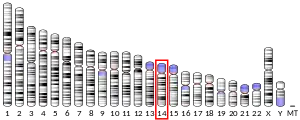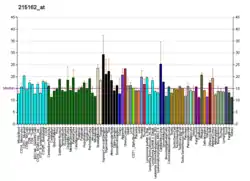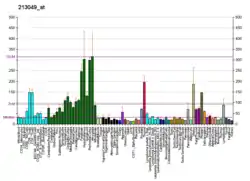| RALGAPA1 | |||||||||||||||||||||||||||||||
|---|---|---|---|---|---|---|---|---|---|---|---|---|---|---|---|---|---|---|---|---|---|---|---|---|---|---|---|---|---|---|---|
| Identifiers | |||||||||||||||||||||||||||||||
| Aliases | RALGAPA1, GARNL1, GRIPE, RalGAPalpha1, TULIP1, p240, Ral GTPase activating protein catalytic alpha subunit 1, Ral GTPase activating protein catalytic subunit alpha 1, NEDHRIT | ||||||||||||||||||||||||||||||
| External IDs | OMIM: 608884 MGI: 1931050 HomoloGene: 84805 GeneCards: RALGAPA1 | ||||||||||||||||||||||||||||||
| |||||||||||||||||||||||||||||||
| |||||||||||||||||||||||||||||||
| |||||||||||||||||||||||||||||||
| |||||||||||||||||||||||||||||||
| Wikidata | |||||||||||||||||||||||||||||||
| |||||||||||||||||||||||||||||||
GTPase-activating Rap/Ran-GAP domain-like 1 is an enzyme that in humans is encoded by the RALGAPA1 gene.[5][6]
References
- 1 2 3 GRCh38: Ensembl release 89: ENSG00000174373 - Ensembl, May 2017
- 1 2 3 GRCm38: Ensembl release 89: ENSMUSG00000021027 - Ensembl, May 2017
- ↑ "Human PubMed Reference:". National Center for Biotechnology Information, U.S. National Library of Medicine.
- ↑ "Mouse PubMed Reference:". National Center for Biotechnology Information, U.S. National Library of Medicine.
- ↑ Shirakawa R, Fukai S, Kawato M, Higashi T, Kondo H, Ikeda T, Nakayama E, Okawa K, Nureki O, Kimura T, Kita T, Horiuchi H (Aug 2009). "Tuberous Sclerosis Tumor Suppressor Complex-like Complexes Act as GTPase-activating Proteins for Ral GTPases". J Biol Chem. 284 (32): 21580–8. doi:10.1074/jbc.M109.012112. PMC 2755882. PMID 19520869.
- ↑ "Entrez Gene: GARNL1 GTPase activating Rap/RanGAP domain-like 1".
Further reading
- Nagase T, Ishikawa K, Suyama M, et al. (1999). "Prediction of the coding sequences of unidentified human genes. XII. The complete sequences of 100 new cDNA clones from brain which code for large proteins in vitro". DNA Res. 5 (6): 355–64. doi:10.1093/dnares/5.6.355. PMID 10048485.
- Heng JI, Tan SS (2003). "Cloning and characterization of GRIPE, a novel interacting partner of the transcription factor E12 in developing mouse forebrain". J. Biol. Chem. 277 (45): 43152–9. doi:10.1074/jbc.M204858200. PMID 12200424.
- Strausberg RL, Feingold EA, Grouse LH, et al. (2003). "Generation and initial analysis of more than 15,000 full-length human and mouse cDNA sequences". Proc. Natl. Acad. Sci. U.S.A. 99 (26): 16899–903. Bibcode:2002PNAS...9916899M. doi:10.1073/pnas.242603899. PMC 139241. PMID 12477932.
- Ota T, Suzuki Y, Nishikawa T, et al. (2004). "Complete sequencing and characterization of 21,243 full-length human cDNAs". Nat. Genet. 36 (1): 40–5. doi:10.1038/ng1285. PMID 14702039.
- Swaminathan S, Kiendl F, Körner R, et al. (2004). "RanGAP1*SUMO1 is phosphorylated at the onset of mitosis and remains associated with RanBP2 upon NPC disassembly". J. Cell Biol. 164 (7): 965–71. doi:10.1083/jcb.200309126. PMC 2172064. PMID 15037602.
- Fortna A, Kim Y, MacLaren E, et al. (2006). "Lineage-Specific Gene Duplication and Loss in Human and Great Ape Evolution". PLOS Biol. 2 (7): E207. doi:10.1371/journal.pbio.0020207. PMC 449870. PMID 15252450.
- Gerhard DS, Wagner L, Feingold EA, et al. (2004). "The Status, Quality, and Expansion of the NIH Full-Length cDNA Project: The Mammalian Gene Collection (MGC)". Genome Res. 14 (10B): 2121–7. doi:10.1101/gr.2596504. PMC 528928. PMID 15489334.
- Schwarzbraun T, Vincent JB, Schumacher A, et al. (2005). "Cloning, genomic structure, and expression profiles of TULIP1 (GARNL1), a brain-expressed candidate gene for 14q13-linked neurological phenotypes, and its murine homologue". Genomics. 84 (3): 577–86. doi:10.1016/j.ygeno.2004.04.013. PMID 15498464.
- Schmid EM, Ford MG, Burtey A, et al. (2007). "Role of the AP2 β-Appendage Hub in Recruiting Partners for Clathrin-Coated Vesicle Assembly". PLOS Biol. 4 (9): e262. doi:10.1371/journal.pbio.0040262. PMC 1540706. PMID 16903783.
This article is issued from Wikipedia. The text is licensed under Creative Commons - Attribution - Sharealike. Additional terms may apply for the media files.






